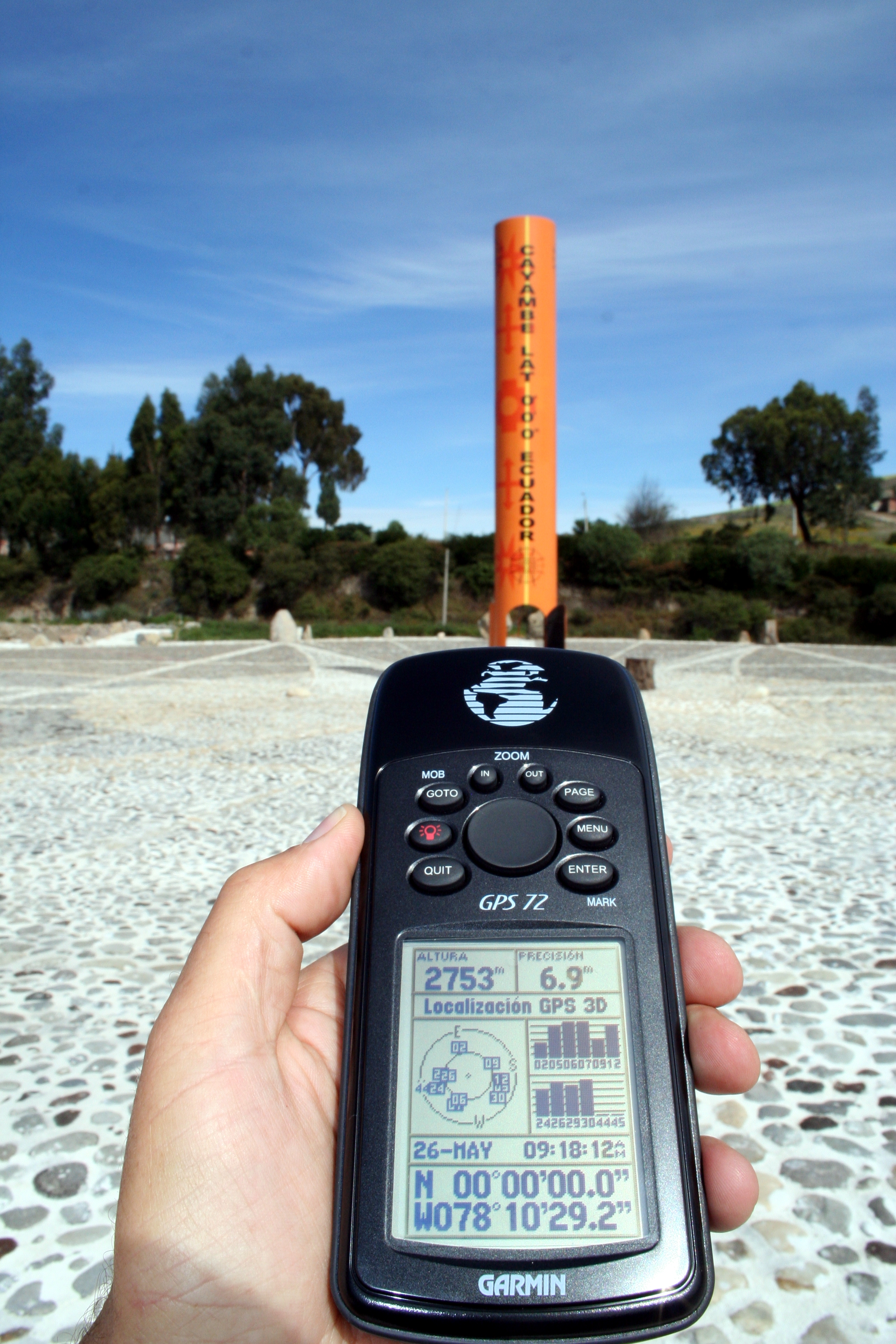Quitsato Sundial on:
[Wikipedia]
[Google]
[Amazon]
The Quitsato Sundial is a cultural-tourist place located at La Mitad Del Mundo, near to Cayambe, 47 km north of Quito, 
 The Ecuadorian Military Geographic Institute has placed two cylinders surrounded by concrete on a platform on top of the Equatorial line, with a 1 mm error margin determined by using
The Ecuadorian Military Geographic Institute has placed two cylinders surrounded by concrete on a platform on top of the Equatorial line, with a 1 mm error margin determined by using
Quitsato Sundial's website.
Buildings and structures in Pichincha Province Sundials Tourist attractions in Pichincha Province Equator monuments 2006 establishments in Ecuador
Ecuador
Ecuador ( ; ; Quechua: ''Ikwayur''; Shuar: ''Ecuador'' or ''Ekuatur''), officially the Republic of Ecuador ( es, República del Ecuador, which literally translates as "Republic of the Equator"; Quechua: ''Ikwadur Ripuwlika''; Shuar: ' ...
. It was built in 2006 and inaugurated in 2007 as an independent, non-profit project in a 24,756 ft² (2300 m²) area. Its main goal is to share crucial aspects of the astronomical
Astronomy () is a natural science that studies celestial objects and phenomena. It uses mathematics, physics, and chemistry in order to explain their origin and evolution. Objects of interest include planets, moons, stars, nebulae, galaxi ...
knowledge of the prehispanic cultures of the region. The expositions are carried out by community members as a self-sustaining project.
Structure
It consists of a circular platform of 54 m (177.64 ft) in diameter which forms a mosaic of light and dark pebbles drawing an eight-pointed star that indicates thesolstice
A solstice is an event that occurs when the Sun appears to reach its most northerly or southerly excursion relative to the celestial equator on the celestial sphere. Two solstices occur annually, around June 21 and December 21. In many countr ...
s and equinox
A solar equinox is a moment in time when the Sun crosses the Earth's equator, which is to say, appears directly above the equator, rather than north or south of the equator. On the day of the equinox, the Sun appears to rise "due east" and se ...
es, plus intermediate lines pointing to the cardinal directions. In the center of this platform there is a 10 m (32.80 ft) high, 1.30 m (4.27 ft) diameter cylindrical orange tube which serves as a gnomon, pointing to the corresponding hours and months of the year in the platform according to the shadow cast by the Sun
The Sun is the star at the center of the Solar System. It is a nearly perfect ball of hot plasma, heated to incandescence by nuclear fusion reactions in its core. The Sun radiates this energy mainly as light, ultraviolet, and infrared radi ...
. The gnomon represents the metric system
The metric system is a system of measurement that succeeded the decimalised system based on the metre that had been introduced in France in the 1790s. The historical development of these systems culminated in the definition of the Interna ...
, based in the meter, which in its origin was intended to equal one ten-millionth of the quadrant of the Earth's circumference. The purpose of the color difference between the stones, apart from showing equinox and solstice lines, is to explain the meaning of albedo
Albedo (; ) is the measure of the diffuse reflection of solar radiation out of the total solar radiation and measured on a scale from 0, corresponding to a black body that absorbs all incident radiation, to 1, corresponding to a body that refl ...
and its use in astronomical study. The Equator line is drawn by using smaller, darker pebbles between two metal plates.
The angles that form the geometric design of the eight-pointed star are given by the tilt of the Earth with respect to the ecliptic
The ecliptic or ecliptic plane is the orbital plane of the Earth around the Sun. From the perspective of an observer on Earth, the Sun's movement around the celestial sphere over the course of a year traces out a path along the ecliptic agains ...
of the Earth, thus the platform itself also presents a reading of the celestial mechanics
Celestial mechanics is the branch of astronomy that deals with the motions of objects in outer space. Historically, celestial mechanics applies principles of physics (classical mechanics) to astronomical objects, such as stars and planets, to ...
. Detailed positions of the solstices and equinoxes, as well as their respective axes, are presented.
 The Ecuadorian Military Geographic Institute has placed two cylinders surrounded by concrete on a platform on top of the Equatorial line, with a 1 mm error margin determined by using
The Ecuadorian Military Geographic Institute has placed two cylinders surrounded by concrete on a platform on top of the Equatorial line, with a 1 mm error margin determined by using GPS
The Global Positioning System (GPS), originally Navstar GPS, is a satellite-based radionavigation system owned by the United States government and operated by the United States Space Force. It is one of the global navigation satellite sy ...
and GNSS
A satellite navigation or satnav system is a system that uses satellites to provide autonomous geo-spatial positioning. It allows satellite navigation devices to determine their location (longitude, latitude, and altitude/elevation) to high pr ...
equipment.
References
{{reflistExternal links
Quitsato Sundial's website.
Buildings and structures in Pichincha Province Sundials Tourist attractions in Pichincha Province Equator monuments 2006 establishments in Ecuador